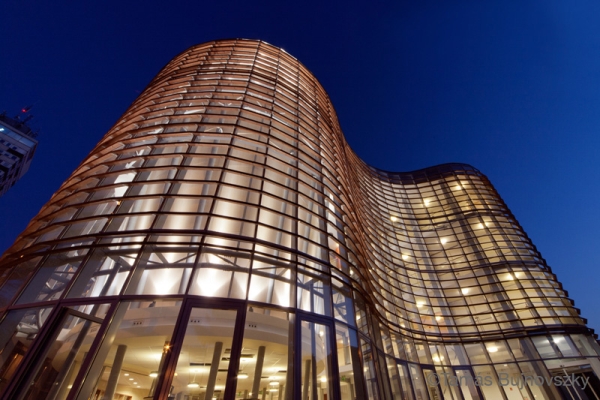The Signs of Present
Tuning Fork Villa in Veszprém
Architects: Anthony Gall, Gabriella Albóciné Ábrahám
Text: Vilmos Katona
Photos: Tamás Bujnovszky

The centre of Veszprém has been an exciting location for the management of the town since the 1960s. Even the younger generation of architects feels some guilt because of the partial demolition of the inner city which was rated as obsolete then, although it featured versatile terrain faculties and road connections. As of today, substantial financial sources are allocated for heritage protection and reconstruction here.
Local press published a first version of the cultural and music centre named Tuning Fork Villa as early as the summer of 2008 as a scheme integrated into the inner city rehab investment sponsored partly by private clients, partly by the local government. In November 2013 the facelifted building hosted an event proving the success of the comprehensive Veszprém-project. Besides remodelling, the former movie theatre went through a change of functions too. The large auditorium today houses music programmes instead of film showings: concerts profit much from the acoustic faculties of the room, delated structure and canopies, although the vaulted parget stone boards were replaced by resonance-free flat wainscotting. The necessary technology and the versatility of the venue necessitated the floor-plan design based on concentric rectangles. The revival of the space and its core reserved for conferences tend to separate today much in the same way from the self-supporting frame of the three-storey foyer as the music hall from the former cast stone facade. The latter is surrounded by a circular outer corridor adjusted to the original module of the movie theatre which today faces the hall as a gallery connecting to it from the north. This raw industrial scaffolding creates a refined transition between various layers of time. Even the three-flight stairway conveys the atmosphere of continuity: contemporary has evolved from ‘outdated’, whilst avantgarde has turned into history.
Concept: Delta Mérnöki Iroda Veszprém
Leading architects: Anthony Gall, Gabriella Albóciné Ábrahám
Architects: Andrea Kovácsné Pikler, Bálint Bors, András Szabó
Structure: István Zalavári, László Holéczy, Veronika Szentes, Viktória Bódy, Balázs Ther i-quadrat hungária Kft.
Air technology, heating: Attila Tuczai
Lights: Zoltán Szurmai
Acoustics: Andor Tamás Fürjes
Fire protection: Sándor Rózsa
Environment: Géza Kovács






